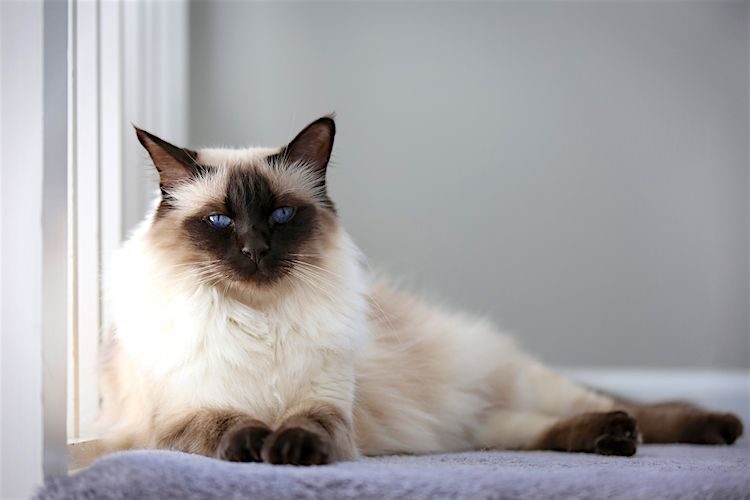
1. Key Characteristics of Balinese Cats
- Weight: 6–8 pounds for males; 5–7 pounds for females
- Life Expectancy: 15–20 years
A Balinese is a Siamese with a long coat.
These graceful, aristocratic cats are medium-sized and muscular with a fine bone structure and a long, slim body.
They have a long, silky coat, but no undercoat. The hair can be as long as 2 inches and comes in many colors.
The coat is typically pointed, meaning concentrations of color appear on the face, ears, legs and tail.
The eyes of Balinese cats are sapphire blue, and the cats’ long, plumed tail has long hair.
2. Where Balinese Cats Came From
Early reports of longhaired Siamese kittens are sparse.
But a breeding program was started in the 1950s to isolate the Siamese kittens with the unique coat.
Breeders Marion Dorsey and Helen Smith developed more of the cats, and Smith named them Balinese because of their graceful movements, which reminded her of the Balinese dancers she admired.
The cats were originally accepted in 4 colors: seal, brown, blue and lilac.
The International Cat Association recognized the breed in 1979, and that same year other colors were allowed, including red, cream, tortoiseshell and pointed coats in various shades and patterns.

3. How Friendly Are Balinese Cats?
Balinese cats are affectionate and bond closely with their family members.
These cats need a lot of attention and don’t like being left alone for a long time.
They can also be mischievous, so keeping a close eye on them is never a bad idea.
Balinese cats can be chatty and vocal but are more quiet than the typical Siamese. They are active and athletic, and they enjoy playing with toys.
They get along well with other animals and children, making them ideal for families with existing pets.
4. Is This the Right Cat for You?
Exercise Needs
HIGH: Although it may be a challenge to get any cat to play and exercise, Balinese cats are active and love playing with toys or making up their own games.
Was YOUR Pet Food Recalled?
Check Now: Blue Buffalo • Science Diet • Purina • Wellness • 4health • Canine Carry Outs • Friskies • Taste of the Wild • See 200+ more brands…

Provide toys, scratching posts and other playful items to help your Balinese expel energy.
Balinese can be destructive at times, so keeping them mentally stimulated is important, especially since they should stay indoors.
Grooming Needs
MEDIUM: Because the Balinese doesn’t have an undercoat, the likelihood of matting or tangling is low, as is shedding.
Even so, brush your Balinese a few times a week to remove dead hair, prevent mats and keep the coat healthy.
The quality time you spend brushing your cat will only help strengthen your bond together.
In addition to brushing, keep the claws trimmed, the ears cleaned and the teeth brushed. This last point is especially important — a Balinese cat is susceptible to periodontal disease.
Health Problems
MEDIUM: While this cat breed is considered to be generally healthy, Balinese cats are susceptible to the same illnesses that can affect Siamese cats, such as:
- Respiratory problems (chronic bronchial disease)
- Crossed eyes
- Kinked tail
- Bladder stones
- Eye problems (glaucoma and retinal atrophy)
- Heart problems
- Cancer
- Periodontal disease
Wow, talk about vocal! Listen to this Balinese kitten:

5. Where to Adopt a Balinese Cat
Purebred cats like the Balinese do occasionally end up in shelters and rescues. Start with our online pet search to find one of these cats near you.
If you contact a Balinese breeder, be watchful for signs that the breeder is running a kitten mill.




